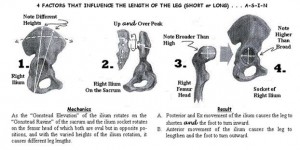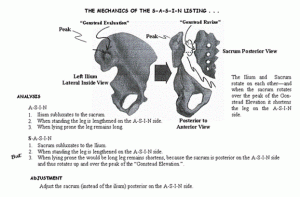Notes from Dr. Gonstead – 1978
These notes are from a Gonstead Advanced Session that Dr. Gonstead taught in West Palm Beach, Florida in February of 1978. The leg check is the key to S-ASIN listing in comparing the long leg that should be on the radiograph (caused by ASIN ilium to the leg check which is checked prone on the Hi Lo.
1. If the leg stays long on the Hi Lo check, adjust the ilium (this is the ilium subluxating to sacrum).
2. If the long leg shortens on the Hi Lo check this indicates that the sacrum has subluxated to the ilium (this is the S-ASIN listing, better to adjust the rotated Sac.)
3. The rotated sacrum should match the lumbar vertebral rotation.
4. The higher the lumbar vertebral rotation goes up the lumbar spine and even the thoracic spine the more likely that sacral rotation is the major culprit.
5. It is my experience that even if (no sacral rotation is visible on the radiograph, this leg check should be used. (Remember the sacrum is the most often malformed bone in the body).
6. After adjusting the S-ASIN listing you should be able to do your prone leg check and the leg difference should be approximately the same as on the radiograph. Continue adjusting the sacrum until your leg check is the same as the x-ray. Approximately three to four visits will usually resolve this problem.
7. This can also be used with a know anatomical short leg that is short on the radiograph. This will appear even shorter on the Gonstead prone leg check and needs to be adjusted in the previously mentioned manner.
Adjusting the rotated sacrum is not trying to also correct a post sacral base or sacral tubercle at the same time, it is adjusting only the rotated sacrum, and that is the S-ASIN problem.


